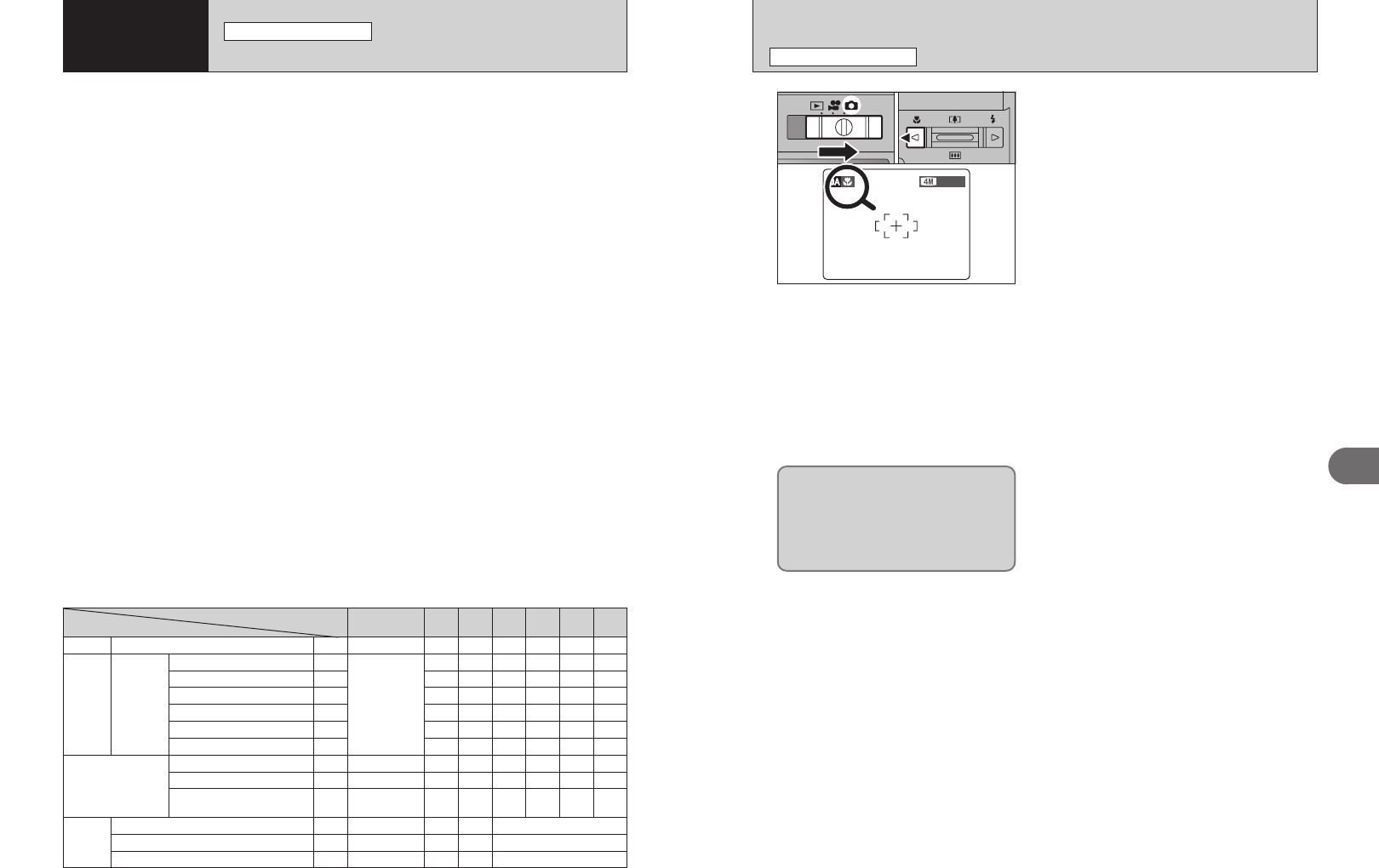
S ISO
30 31
Advanced Features
3
Consider the scene you are photographing and the sort of image you want to
achieve when you specify the camera settings. A general guide is given below.
1
Select the Shooting mode (➡P.39).
a
AUTO Specifies all settings other than Quality, Sensitivity and
FinePix COLOR on the camera.
s
MANUAL Sets the “EV” and “White balance” to manual to easily
control yourself.
m
PORTRAIT Uses for photography getting beautiful skin tones and
soft overall tone.
,
LANDSCAPE Uses for shooting scenery in daylight.
.
SPORT Uses for shooting sporting events.
/
NIGHT Uses for shooting evening and night scenes.
2
Specify the photography settings (➡P.31-33, 37, 38, 40).
e
Macro Uses for close-up shots.
d
Flash Uses for shots in dark locations or for backlit subjects,
etc.
*
Self-timer Uses in situations such as group shots where the
photographer is included in the shot.
D
EV (Exposure compensation)
Uses the AE exposure as a reference value of 0, this
function brightens (+) or darkens (–) the shot.
A
White balance Uses to fix the white balance to suit the photography
conditions and lighting.
3
Take the pictures (check the exposure and focus ➡ adjust
the shot composition ➡ press the shutter button down fully).
Select Macro mode to take close-up shots.
1Set the Mode switch to “q”.
2Press the “e (d )” Macro button. The “e”
appears on the LCD monitor indicating that you
can take close-up shots.
To cancel Macro mode, press the “e (d)”
Macro button again.
h Focal range
Wide-angle: Approx. 9 cm to 80 cm
(3.5 in. to 2.6 ft.)
Telephoto : Approx. 39 cm to 80 cm
(1.3 ft. to 2.6 ft.)
h Effective flash range
Approx. 30 cm to 80 cm (1.0 ft. to 2.6 ft.)
h Optical zoom focal length
✽
Approx. 38 mm-130 mm, max. zoom scale: 3.4×
h Digital zoom focal lengths
✽
2: approx. 130 mm-182 mm,
max. zoom scale: approx. 1.4×
1: approx. 130 mm-234 mm,
max. zoom scale: approx. 1.8×
`: approx. 130 mm-468 mm,
max. zoom scale: approx. 3.6×
✽ 35 mm camera equivalents
●
!
Any of the following cancels Macro mode:
i Changing the Mode switch setting
i Turning the camera off
●
!
Select the appropriate flash mode for the conditions.
●
!
Use a tripod to avoid camera shake when shooting in the
dark (when “
∂” appears).
●
!
Once the LCD monitor is turned on it cannot be turned off in
this mode.
●
!
When canceling Macro mode, the LCD monitor remains on.
01 02
TAKING PICTURES — SELECTING THE CAMERA SETTINGS
PHOTOGRAPHY FUNCTIONS
3
Advanced
Features
■ Photography mode specifications
d
e MACRO
YES
c
d FLASH
FinePix Photo mode
Auto flash
bRed-eye reduction
d Forced flash
v Suppressed flash
c Slow synchro
n
Red-eye reduction + Slow syncro
y Quality
J FinePix COLOR
YES
YES
NO
YES
YES
NO
NO
YES
Menu
* Self-timer
NO
D EV (Exposure Compensation)
A White balance
a
YES
YES
YES
YES
YES
YES
YES
YES
YES
YES
s
YES
YES
YES
YES
YES
YES
NO
m
NO
NO
NO
YES
NO
NO
NO
,
YES
NO
YES
YES
NO
NO
NO
.
NO
NO
NO
YES
YES
YES
YES YES YES YES YES YES
YES YES YES YES YES YES
NO
/
Default Setting
OFF
AUTO
4 N
p-STANDARD
OFF
0
AUTO
YES
NO
NO
P.31
P.32
P.32
P.33
P.33
P.33
P.33
P.34
YES YES YES YES YES YESAUTOP.35
P.36
P.38
P.40
P.40
e MACRO
(
CLOSE-UP
)
PHOTOGRAPHY FUNCTIONS
When using the viewfinder to take a
picture in Macro mode, the field visible
through the viewfinder does not match
the field actually photographed because
the viewfinder and lens are in different
positions. Use the LCD monitor to take
pictures in Macro mode.


















